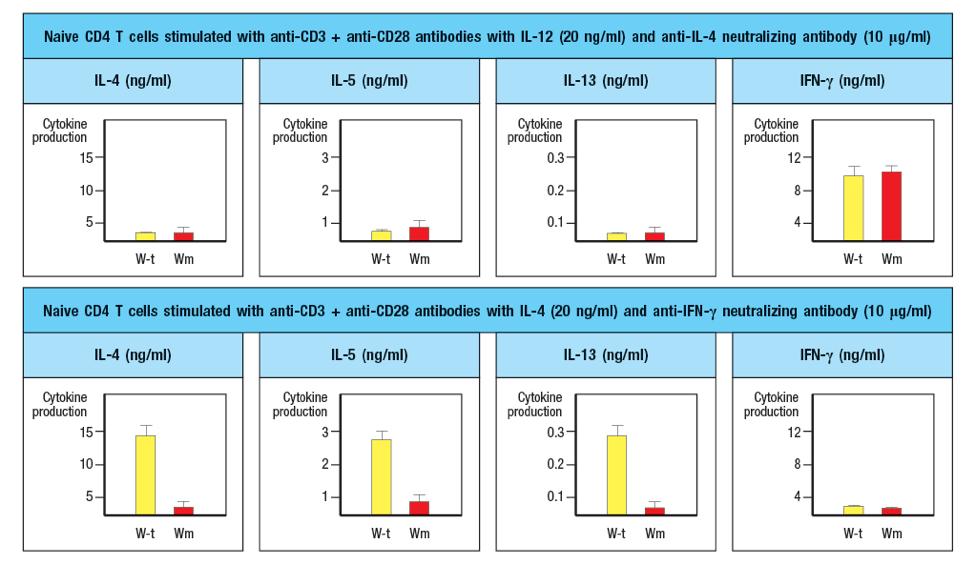Question
A mouse line (called Wm) is discovered that has an unexpected immunodeficiency. Genetic studies indicate that the immunodeficiency is due to a single gene defect.
A mouse line (called ‘Wm’) is discovered that has an unexpected immunodeficiency. Genetic studies indicate that the immunodeficiency is due to a single gene defect. Wm mice have normal numbers of all immune cell lineages, including T cell, B cells, macrophages, dendritic cells, NK cells, and granulocytes. Also, when infected with viruses or intracellular bacteria and protozoa, Wm mice mount normal protective T cell responses and clear the infections. However, when given a helminthic parasite infection, Wm mice cannot clear the parasites and die from the infection. A set of wild-type (WT) and Wm mice were infected with the helminthic parasite, Nippostrongylus brasiliensis, and cytokine production by CD4 T cells was analyzed. For this experiment, CD4 T cells were isolated from mice at day 8 post-infection, stimulated in vitrofor 24 hr stimulation with anti-CD3 antibody to elicit cytokine secretion, and then cytokine levels in the culture supernatants were examined by ELISA. The results are shown in Figure 2.A below.
Figure 2.A

a) What appears to be the problem in Wm mice? Explain your reasoning.
b) List three possible candidates for the defect in Wm mice. Note that the transcription factor GATA-3 is nota likely candidate gene, as GATA-3-deficient mice have an early block in T cell development in the thymus, and completely lack all T cells.
To learn more about the defect in Wm mice, naive CD4 T cells were isolated from wild-type and Wm mice and stimulated in vitrowith anti-CD3 plus anti-CD28 antibodies to artificially induce activation. These CD4 T cells were activated either in the presence of additional cytokines, or blocking antibodies, as indicated in the figure. After three days of stimulation, T cells are isolated, washed, and restimulated with anti-CD3 antibody in medium lacking any cytokines or antibodies. After 24 hr, the cytokines present in the supernatants of these re-stimulated CD4 T cells are examined by ELISA. These data are show in Figure 2.B below.
Figure 2.B

c) Based on these results, what is a possible explanation for the defect in Wm mice? Explain your reasoning.
IL-4 (ng/ml) IL-5 (ng/ml) IL-13 (ng/ml) IFN-y (ng/ml) Cytokine production Cytokine production Cytokine production Cytokine production 15- 3- 0.3- 12- 10- 2- 0.2- 8- 5- 1- 0.1- 4- W-t Wm W-t Wm W-t Wm W-t Wm
Step by Step Solution
3.49 Rating (152 Votes )
There are 3 Steps involved in it
Step: 1
1 The problem with Wm mice as can be inferred from results is that although the levels of Interferon gamma is similar in Wm mice and wild type mice la...
Get Instant Access to Expert-Tailored Solutions
See step-by-step solutions with expert insights and AI powered tools for academic success
Step: 2

Step: 3

Document Format ( 2 attachments)
635df22d3cf29_180195.pdf
180 KBs PDF File
635df22d3cf29_180195.docx
120 KBs Word File
Ace Your Homework with AI
Get the answers you need in no time with our AI-driven, step-by-step assistance
Get Started


